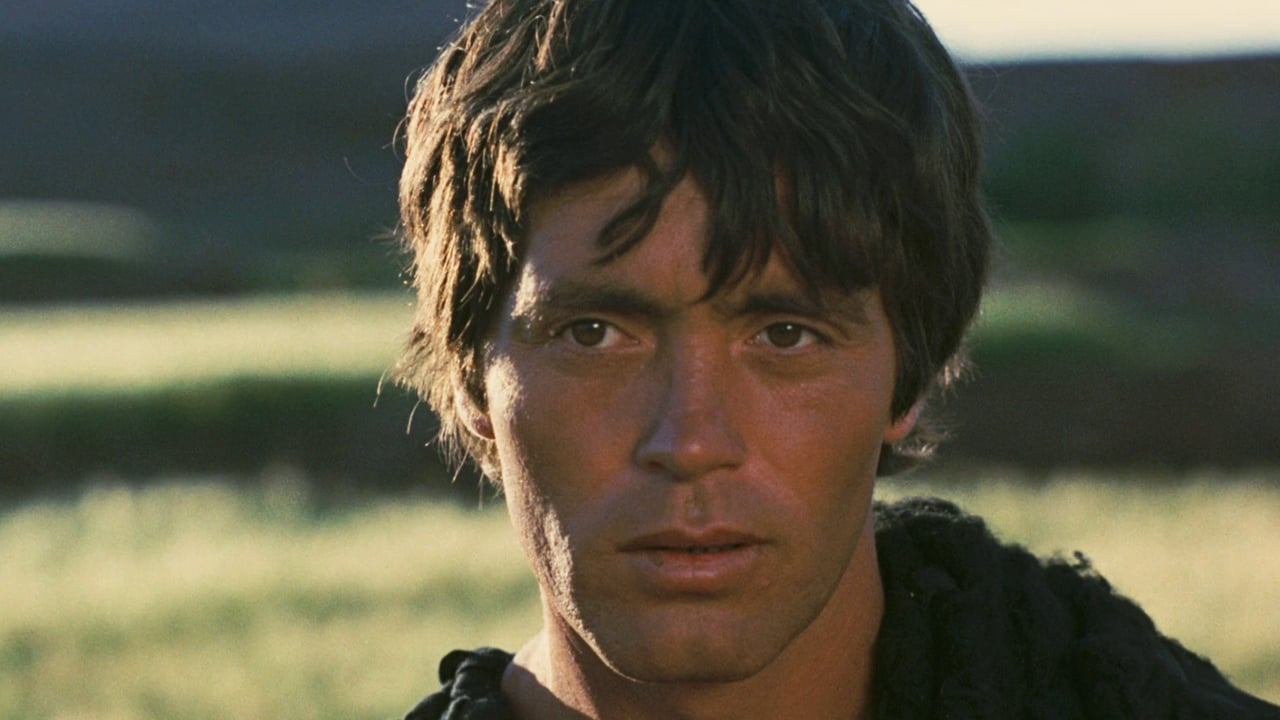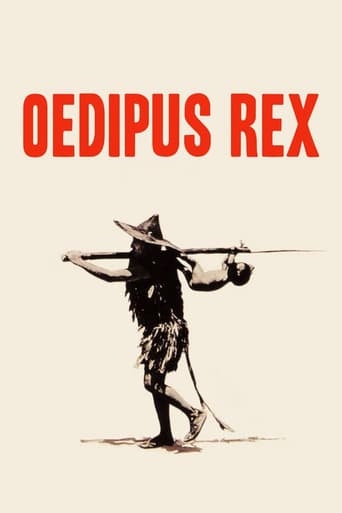Libramedi
Intense, gripping, stylish and poignant
CrawlerChunky
In truth, there is barely enough story here to make a film.
Adeel Hail
Unshakable, witty and deeply felt, the film will be paying emotional dividends for a long, long time.
Alistair Olson
After playing with our expectations, this turns out to be a very different sort of film.
Kirpianuscus
one of films who remands. the rules of Greek tragedy. the limits of interpretation. the manner to use the myth as contemporary mirror. the art of Piero della Francesca. the conflict between past and present. a film of actors. because each trace of acting defines not the vision of Pasolini about the fate of king from Thebes but its search of truth. the truth - basis of all. Edipo re impress. for atmosphere, for costumes and the use of myth.the eyes of Franco Citti. the presence of Silvana Mangano. the first scenes who are parts from a possible Visconti. the end as warning about the price of fight against yourself. Edipo re is support for reflection. not a new version of well known myth because the important details of myth are insignificant. not example of high art. because it is far to be a show. it is only exploration of meanings. and the sketch about different forms of pride and sacrifice. looking for authenticity. precise definition of life.
chaos-rampant
Another marvelous film by Pasolini.No one is as cinematically intense as this man, but it's not an ordinary intensity he affects. It does not result from the withholding of narrative or visual information, it is not primarily a dramatic intensity; Lean, Hitchcock, Kurosawa, all did some terrific work in that external mode where we see the struggling human being in the cleanly revealed world of choices and fates. Pasolini works his way around all that, starting with one of the most archetypal stories. Here we have anticipation, foreknowledge as fate. And of course there is some dramatic intensity in this and others of his films, but that's not what makes him special. He can create heightened worlds that we experience with a real intensity. It goes back to that film movement called Neorealism which thrived in postwar Italy, where the utmost goal was to soak up a more human, more universal conflict as we staggered through broken pieces of the world.Looking back now it seems stale, we have a much more refined sense of what is real, we can see the conceit of the camera. But two filmmakers emerged from out of this movement who did work in a more radical direction, moving the images closer to perception. Antonioni is one of the greatest adventures in film. Pasolini is the other. The larger point with him is to have an intensely spiritual experience of a whole new storyworld, to that effect he selects myths that we have more or less fixed notions about how they should be (this, Medea, his Gospel film) and films them to have invigorating presence in the now.Every artistic choice in the film reflects that; the dresses, the swords, the landscapes, the faces, it's all intensely unusual to what you'd expect from Greek myth, seemingly handcarved to be from a preconscious world outside maps and time. The camera also reflects that; he could have plainly asked of a fixed camera and smooth, fixed traveling shots from his crew, but evidently he wants that warm lull of the human hand. It's a different sort of beauty, not in some painted image but in our placement in evocative space.When Oedipus visits the oracle at Delphii, we do not have sweeping shots of some ornate marble structure as you'd expect in a Hollywood film. A congregation of dustcaked villagers is gathered in a clearing before a group of trees, the oracle is a frightening old crone attended by slender boys in masks. The roads are dusty, interminable ribbons dropped by absent-minded gods. A Berber village in Morocco stands for ancient Thebes. Sudden dances. Silvana Mangano. And those headgear! It's all about extraordinariness in the sense of moving beyond inherited limits of truth.It works. This is a world of divinity, causal belief, and blind seeing into truth that even though it was fated, we discover anew in the sands.The sequence where a feverish Oedipus confronts his father at the crossroads will stay with me for a long time, the running, the sun, the distance where tethers are pulled taut.
hasosch
Like in other Pasolini movies, we have here two parallel told stories: There is a first "Oedipus", in the 20ies of the 20th century, a baby is nursed by his beautiful mother, sitting on a meadow. His father is afraid that the baby will steal his love. Then there is the second "Oedipus", based on Sophocles, but very freely interpreted by Pasolini, both what concerns the landscape (Southern Italy, Maroque) and the costumes, as well as the original texts (Pasolini shows parts of "Oedipus on Kolonos"). Otherwise, we are told here the mystic story of Oedipus, who is left by his parents, grows up with the king of Korinthos, gets to kill his father and to marry his mother, being fully unaware of what he is doing: he is doomed. At the end, the first Oedipus is coming back: As a blind beggar (the mystic Oedipus was blinded on his own wish) he sits in front of the cathedral of Bologna, is accompanied by a young boy and seeks that meadow where the movie started."Edipo Re" (1967) is one of those films by P.P. Pasolin about which we have extensive comments by the author and film director. Pasolini considered this film autobiographic, being himself that baby on that meadow suckling the milk from his beautiful mother's breast and causing unintentionally his fascist-fathers hatred. He made himself responsible for the death of him whom he loved and hated at the same time. Also, in this picture, there is the complicated relationship of the gay-man towards his mother which Pasolini called "latent". Pasolini wrote that he intended a completely metaphorical and mysticized autobiography, but instead of projecting the myth onto psychoanalysis, he would project psychoanalysis on the myth. So, there is only to say that we know Pasolini's mother Susanna from several of her son's movies in which she played minor, but often crucial roles - in the "Gospel according to St. Matthew" she was the old Marie ... .
Fisher L. Forrest
I have heard some say this film, as far as it interprets the old legend, is "a piece of c***". I would not go that far, there are some good bits, but Pasolini's approach to telling a story on film is definitely not to my taste. The editing is rough, some of the actors just seem to walk through, like Silvana Mangano as Iocasta, others, like Pasolini himself as Oedipus seem in a constant manic state. You have to look fast to see Alida Valli as Merope, but her performance is the one I remember with the most pleasure. The camera work is unrelentingly stark to the point of boredom. And why, in the name of Pete, that modern "book-end" at the beginning and the end? No sense at all to it, unless Pasolini is trying to say "this is a story for all ages", but, heck, I already knew that.The story as Pasolini tells it follows Sophocles fairly well, with touches taken from Homer, but he doesn't mind going off on his own once in a while. If there is anyone who doesn't know the story, don't read any more until you have seen the film (there's an excellent DVD). In Sophocles, after Oedipus finally realises he has killed his father and fathered four children with his mother as his wife, he blinds himself. Pasolini leaves us there by going back to his modern conclusion. Actually, in the legend, his two daughters, Ismene and Antigone (subjects of another play by Sophocles) guide him on his way to Athens where he ultimately dies. I wish Pasolini had at least given us a glimpse of the girls and this journey. Oh, well, just call me a philistine who doesn't appreciate "real art".

